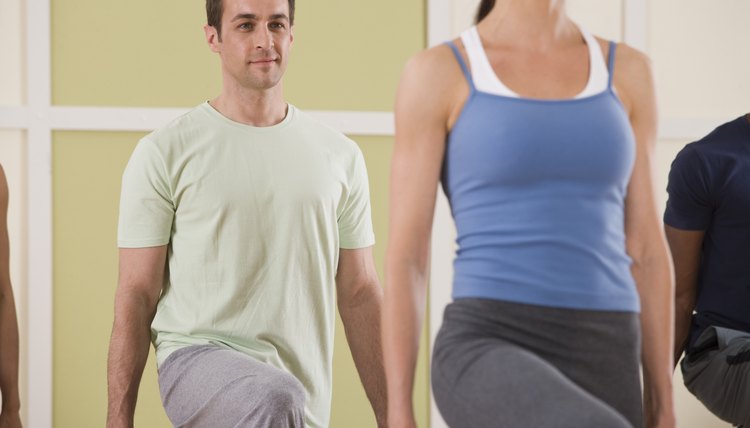The Ratio of Hamstring Strength

The hamstring muscles in the lower body are often overlooked when working out in the weight room, but it's important that they possess an adequate amount of strength in comparison with the quadriceps in order to prevent injury. Track participants and other athletes required to sprint in their sport are often the most susceptible to hamstring weakness injury. You can test your hamstring to quadriceps ratio and participate in strength training to improve your ratio as necessary.
Hamstring
The hamstring muscle group consists of three muscles, including the simitendinosus, semimembranosus and the biceps femoris. The muscle group runs down the back of your thigh, originating up at your pelvis and inserting down at tibia and fibula, or your lower leg. Together, they are involved in knee flexion and hip extension.
Hamstring to Quadriceps Strength Ratio
The quadriceps muscle group runs along the front of the upper thigh and consists of four muscles, including the vastus intermedius, vastus lateralis, vastus medialis and rectus femoris. The quariceps are responsible for extending the knee and flexing the hip, which is movement opposite to that of the hamstrings. The strength ratio of hamstrings to quadriceps should be at least 60 percent but ideally 75 percent.
Significance
The hamstrings are highly susceptible to injury, typically caused by a pulled hamstring, or muscle strain. They typically occur when a person is sprinting and are commonly caused by a lack of hamstring strength to quadriceps strength ratio. A lack of hamstring strength can also put you at an increased risk of injury to the ACL, or anterior cruciate ligament, which is a ligament that facilitates with knee stability.
Testing
To test whether your hamstrings are at the proper strength ratio compared to quadriceps, complete one repetition maximum tests for both the leg curl and leg extension exercises. Divide your leg curl score by your leg extension curl to find the ratio. For example, if your leg extension maximum is 85 lbs. and your leg curl maximum is 50 lbs., your strength ratio would be found by dividing 50 by 85, or 0.59. This can also be expressed as 59 percent.
Strengthening
Exercises effective at developing the strength of the hamstring muscle group include deadlifts, exercise ball hamstring and kneeling hamstring curls. To significantly improve strength, complete workout sessions two to three days per week. Each exercise should be completed at a volume of two to three sets of six to 12 repetitions.
References
- Journal of Sports Science and Medicine: Develoments in the Use of the Hamstring/Quadriceps Ratio for the Assessment of Muscle Balance
- Messer DJ, Bourne MN, Williams MD, Al Najjar A, Shield AJ. Hamstring muscle use in women during hip extension and the Nordic hamstring exercise: a functional magnetic resonance imaging study. J Orthop Sports Phys Ther. 2018;48(8):607-612. doi:10.2519/jospt.2018.7748
- Erickson LN, Sherry MA. Rehabilitation and return to sport after hamstring strain injury. J Sport Health Sci. 2017;6(3):262–270. doi:10.1016/j.jshs.2017.04.001
- Cleveland Clinic. Is your leg pain sciatica or something else? Updated December 10, 2019.
- Schmitt B, Tim T, McHugh M. Hamstring injury rehabilitation and prevention of reinjury using lengthened state eccentric training: a new concept. Int J Sports Phys Ther. 2012;7(3):333–341.
- American Academy of Pediatrics. Treating sports injuries with ice and heat. Updated November 21, 2015.
- Shanks P, Curran M, Fletcher P, Thompson R. The effectiveness of therapeutic ultrasound for musculoskeletal conditions of the lower limb: A literature review. Foot. 2010;20(4):133-139. doi:10.1016/j.foot.2010.09.006
- Ramos GA, Arliani GG, Astur DC, Pochini AC, Ejnisman B, Cohen M. Rehabilitation of hamstring muscle injuries: a literature review. Rev Bras Ortop. 2016;52(1):11–16. doi:10.1016/j.rboe.2016.12.002
- Chu SK, Rho ME. Hamstring injuries in the athlete: diagnosis, treatment, and return to play. Curr Sports Med Rep. 2016;15(3):184–190. doi:10.1249/JSR.0000000000000264
Writer Bio
Kim Nunley has been screenwriting and working as an online health and fitness writer since 2005. She’s had multiple short screenplays produced and her feature scripts have placed at the Austin Film Festival. Prior to writing full-time, she worked as a strength coach, athletic coach and college instructor. She holds a master's degree in kinesiology from California State University, Fullerton.
